ISTQB ISTQB-CTFL ISTQB Certified Tester Foundation Level (CTFL v4.0) Exam Practice Test
ISTQB Certified Tester Foundation Level (CTFL v4.0) Questions and Answers
Which of the following provides the BEST description of statement coverage?
Which of the following statements about checklist-based testing is TRUE?
In what way do Configuration Management effects testing?
Which of the following statements about Experience Based Techniques (EBT) is correct?
Which activity is NOT documented in a test plan?
Given the following User Story: "As an online customer, I would like to be able to cancel the purchase of an individual item from a shopping list so that it only displays the relevant items, in less than 1 second", which of the following can be considered as applicable acceptance test cases?
I.Click on my online shopping list, select the unwanted Item, delete the unwanted item, the unwanted Item is deleted from the shopping list in less than 1 second.
ii.Click on my online shopping list, select all the items, delete all the items, the unwanted items are deleted from the shopping list in less than 1 second.
iii.Tab to the online shopping list and press enter, select the unwanted item, delete the unwanted item, the unwanted item is deleted from the shopping list In less than 1 second.
Iv. Click on the checkout button, select the payment method, make payment, confirmation received of payment and shipping date.
v. Click on my shopping list, select the unwanted Item, delete the unwanted item, the unwanted item is deleted from the shopping list.
Select the correct answer:
Which of the following statements about test reports are TRUE?
I Test reports shall be approved by the test team.
II. Test reports shall give stakeholders information as basis for decisions.
Ill Test reports shall summarize what happened through a period of testing.
IV. Test reports shall be approved by the development team, the test team and the customer
V. Test reports shall include information about remaining risks.
Which of the following BEST matches the descriptions with the different categories of test techniques?
1.Test cases are based on the test basis which may include the requirements, use cases and user stories
2.Test cases are based on the test basis which may include the software architecture or code
3.Test cases can show deviations from the requirements
4.These test techniques are applicable to both functional and non-functional testing
5.Tests are based on knowledge of developers, users and other stakeholders
Black - Black-box test techniques
White * White-box test techniques
Experience - Experience-based test techniques
What is test oracle?
Which of the following statements about impact of DevOps on testing is CORRECT?
A requirement specifies that if the total amount of sales (TAS) made during the year by a corporate seller is 300,000€ or more, the bonus that must be paid to the seller is 100% of a certain amount agreed upon at the beginning of the year. The software contains a fault as it implements this requirement with the decision "IF (TAS = 300,000)" instead of "IF (TAS >= 300.000)". The application of the 3-value boundary value analysis to this problem consists of the following three test cases (TAS is an integer variable):
TC1 = 299,999 TC2=300,000 TC=300,001
Which of the following statements is TRUE?
The ISTOB glossary defines Quality Assurance as: "Pail or quality management focused on providing confidence that quality requirements will be fulfilled. Which of the following Is not one of the Quality Assurance activity?
Which ONE of the following is a CORRECT example of the purpose of a test plan?
Which of the following statements describes regression testing?
I. Retesting of a fixed defect
II. Testing of an already tested program
III. Testing of new functionality in a program
IV. Regression testing applies only to functional testing
V Tests that do not nave to be repeatable, because They are only used once
Which of the following answers describes a reason for adopting experience-based testing techniques?
Which of the following about typical information found within a test plan is FALSE?
Atypical generic skill required for the role of tester is the ability to
Which statement about use case testing is true?
A company wants to reward each of its salespeople with an annual bonus that represents the sum of all the bonuses accumulated for every single sale made by that salesperson. The bonus for a single sale can take on the following four values: 3%, 5%, 7% and 10% (the percentage refers to the amount of the single sale). These values are determined on the basis of the type of customer (classified as "Basic" or "Premium") to which such sale was made, and on the amount of such sale classified into the following three groups G1, G2 and G3:
• [G1]: less than 300 euros
• [G2]: between 300 and 2000 euros
• [G3]: greater than 2000 euros
Which of the following is the minimum number of test cases needed to cover the full decision table associated with this scenario?
Following a risk-based testing approach you have designed 10 tests to cover a product risk with a high-risk level. You want to estimate, adopting the three-point test estimation technique, the test effort required to reduce the risk level to zero by executing those 10 tests. You made the following three initial estimates:
• most optimistic = 6 person hours
• most likely = 30 person hours
• most pessimistic = 54 person hours
Based only on the given information, which of the following answers about the three-point test estimation technique applied to this problem is true?
Which of the following is an example of the absence-of-errors fallacy?
In maintenance testing, what is the relationship between impact analysis and regression testing?
Which ONE of the following options BEST describes a key characteristic of non-functional testing?
Which of the following statements about static testing and dynamic testing is true?
A state transition diagram describes a control system’s behavior in different operational modes. The initial state is “NORMAL MODE”.
Which ONE of the following test cases covers an INVALID sequence?
The tests at the bottom layer of the test pyramid:
An organization is working on updating test cases for a particular module of their software. Sam updated a set of test cases yesterday and saved the new version on his PC.
Unfortunately, the hard disk of his PC crashed, and his work was lost.
The IT department of the organization restored the contents of his hard disk with the last available back-up - from the previous morning. However, the changes made by him yesterday were lost forever.
Which of the following tools had it been used, would have prevented the loss of Sam's updates?
A minimum of 0 and a maximum of 40 points can be achieved in a Certified Tester Foundation examination. With a score of 26 points to 36 points inclusive, the exam is considered "passed", with 37 points or higher it is "passed with distinction" and with less than 26 points the examination is "not passed".
Which of the following sets of positive integers fully covers a 2-value boundary value analysis ? (No values from invalid equivalence classes should be specified).
Which of the following statements refers to a good testing practice that applies to all software development lifecycles?
Which ONE of the following options BEST describes the purpose of confirmation testing versus regression testing?
Consider the following user story about an e-commerce website's registration feature that only allows registered users to make purchases ; As a new user, I want to register to the website, so that I can start shopping online"
The following are some of the acceptance criteria defined for the user story
[a] The registration form consists of the following fields: username, email address, first name, last name, date of birth, password and repeat password.
[b] To submit the registration request, the new user must fill in all the fields of the registration form with valid values and must agree to the terms and conditions.
[c] To be valid, the email address must not be provided by free online mail services that allow to create disposable email addresses. A dedicated error message must be presented to inform the new user when an invalid address is entered.
[d] To be valid, the first name and last name must contain only alphabetic characters and must be between 2 and 80 characters long A dedicated error message must be presented to inform the new user when an invalid first name and/or the last name is entered
[e] After submitting the registration request, the new user must receive an e-mail containing the confirmation link to the e-mail address specified in the registration form
Based only on the given information, which of the following ATDD tests is MOST LIKELY to be written first?
A requirement specifies that a certain identifier (ID) must be between 5 and 10 characters long, must contain only alphanumenc characters, and its first character must be a letter As a tester, you want to apply one-dimensional equivalence partitioning to test this ID. This means that you have to apply equivalence partitioning individually: to the length of the ID, the type of characters contained within the ID, and the type of the first character of the ID. What is the number of partitions to cover?
Which ONE of the following options is NOT a benefit of test automation?
Which of the following statements regarding inspection is NOT true?
Which of the following statements BEST describes the shift-left approach in software testing?
Which of the following definitions is NOT true?
Which review type, also known as a “buddy check”, is commonly used in Agile development?
Which of the following is NOT an objective of testing?
A software company decides to invest in reviews of various types. The thought process they have is that each artifact needs to be reviewed using only one of the review methods depending on the criticality of the artifact.
The testers in company A were part of the development team. Due to an organizational change they moved to be part of the support team.
What are the advantages and the disadvantages of this change?
Given the following state model of sales order software:
PLACED -> IN PRODUCTION
IN PRODUCTION -> CANCELLED
IN PRODUCTION -> SHIPPED
SHIPPED -> INVOICED
INVOICED -> CANCELLED
CANCELLED -> PLACED
Which of the following sequences of tran-sitions provides the highest level of tran-sition coverage for the model (assuming you can start in any state)?
For the following pseudo-code determine number of tests required for 100% statement coverage
IF Gender = Boy
If Age > 3 AND Age < 5
Shoe Size = 1
ELSE IF Age >=5 AND Age < 7
Shoe Size = 2
ENDIF
ELSE
IF Age > 3 AND Age < 5
Shoe Size = 0
ELSE IF Age >=5 AND Age < 7
Shoe Size = 1
ENDIF
ENDIF
The following part of a business process flow is specified; REPEAT (book a bill) UNTIL (User presses Cancel). How many test cases are necessary in order to achieve 100% branch coverage of the process flow?
Which of the following statements regarding the impact of the chosen software development lifecycle model on testing is true?
Which of the following is NOT a typical debugging activity when a failure is triggered by dynamic testing?
Which of the following is a test-first approach, where tests that express a shared understanding from stakeholders of how the application is expected to work, are first written in business-readable language (following the Given/When/Then format), and then made executable to drive development?
Consider a program that computes the factorial of a number (n). From the specifications you know that:
• I n < 0. a message "Value out of range" must be issued.
• If 0 < n < 100, the program calculates the factorial and returns the number
• If 100 < n < 200 message "Value out of range" must be issued
For a mandatory input field "ZIP code" the following rules are given:
1 - The valid ZIP code format is 5 numeric digits.
2 - The code has to exist in the post office's official ZIP code list
Using equivalence classes partitioning, how many test cases are required to test this field?
Determining the schedule for each testing activity and test milestones for a test project, using activity estimates, available resources, and other constraints is a typical task performed during
Which of the following statements about the test pyramid is TRUE?
"Statement Testing" is part of;
An application is subjected to a constant load for an extended period of time as part of a performance test While running this test, the response time of the application steadily slows down, which results in a requirement not being met This slowdown is caused by a memory leak where the application code does not properly release some of the dynamically allocated memory when it is no longer needed. Which of the following statements is TRUE?
Which of the following statements about re-testing and regression testing are TRUE?
I Re-testing should be performed after a defect is fixed.
II Regression testing should always be performed after a defect is fixed.
III. Re-testing and regression testing may be performed at any test level.
IV Regression testing may include functional, non-functional and structural testing.
V. Re-testing should be included in the debugging activity.
For each test case to be executed, the following table specifies its dependencies and the required configuration of the test environment for running such test case:
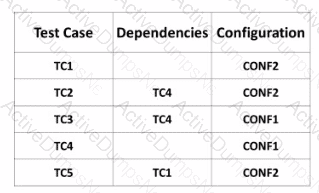
Assume that C0NF1 is the initial configuration of the test environment Based on this assumption, which of the following is a test execution schedule that is compatible with the specified dependencies and allows minimising the number of switches between the different configurations of the test environment^
Software was found lo take much more time than the stated requirement of less than one second to save a file. Upon investigation it was found that there was an unnecessary check inside a loop which was slowing down the file-save operation. The software not being able to meet the desired response time is an example of
An agile software development organization has recently hired a senior tester. The organization has distributed teams spread across time zones. They need to share test status with various stakeholders including upper management and customers at a regular interval. Which of the following statements seems to be correct with regards to the communication?
What does configuration management enable for testing?
Which of the statements on confirmation testing and regression testing is correct?
Which of the following statements is true?
For the same financial institution in Question 12, with the same requirements and expectations, what would be the most likely investment values used in testing if two-point boundary value analysis is used to design test cases specific to the 13% interest rate equivalence partition?
Which of the following is true about Oracles?
Which of the following coverage criteria results in the highest coverage for state transition based test cases?
Which of the following options should NOT be used for writing acceptance criteria?
Which ONE of the following options BEST describes black-box test techniques?
Which of the following is a test task that usually occurs during test implementation?
Exploratory testing is an experience-based test technique
Manager responsibilities in formal review includes ad except one of the following:
Which of the following is an INCORRECT statement about the benefit of traceability between the test basis and test work products?
Which of the following BEST distinguishes the terms "validation" and "verification"?
As a result of the joint evaluation of a product version with the customer, it has been concluded that it would be appropriate to retrieve an earlier version of the product and carry out a benchmark. Depending on the result, further development will be carried out based on the current version or the retrieved version.
Which mechanism, process, and/or technique will allow the specific version (including the testing work products) of a given software product to be restored?
Scenario 1 “Happy Tomatoes” (used for questions 20-22):
An intelligent application for agricultural use incorporates temperature sensors located at different points of an enclosure. The sensors measure and record the temperature at regular intervals and extract the statistical values for these measurements. These values include the average daily temperature.
A new variety of tomatoes is currently being grown and the “World Organization for Happy Tomatoes” has established temperature ranges related to vegetative development.
When the system establishes that the average temperature is within a specific range, it emits a value that will be used to monitor and control the crop.

Using the equivalence partitioning technique, identify the set of input values that provides the HIGHEST coverage.
Why it is essential that defects found in a review be reported objectively?
Which ONE of the following options explains a benefit of independent testing the BEST?
Which of the following is a task the Author is responsible for, as part of a typical formal review?
Which of the following project scenario gives the BEST example where maintenance testing should be triggered?
Test automation allows you to:
You are testing a system that is used in motor vehicles to warn the driver of an obstacle when re-versing. Output is provided by a series of LED lights (green, yellow, and red), each illuminated based on clearly defined conditions.
The following summary describes the functionality:
•Object within 10 metres, green LED lit.
•Object within 5 metres, yellow LED lit.
•Object within 1 metre, red LED lit.
•Setting sensitivity mode to "ON" will result in only the red LED being lit when the object is within 1 metre.
The following decision table describes the rules associated with the functioning of this proximity warning system:
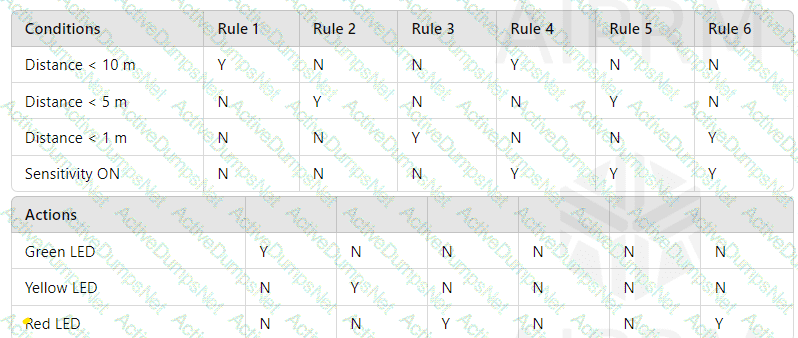
Which intended functionality is tested by Rule 5 in the decision table?
Which of the following is not an example of a typical content of a test completion report for a test project?
Which of the following statements is the BEST example of non-functional testing?
Match each objective to the correct test level
Objective:
A)Verifying whetherthe functionalandnon-functlonalbehaviorsof the system are as designed andspecified.
B)Verifying whetherthe functionalandnon-functlonalbehaviorsof the interfaces are as designed.
C)Verifying whetherthe functionalandnon-functionalbehaviorsof the components are as designedand specified.
D)Establishing confidence in the quality of the systemas a whole.
Test Level:
1.Component testing.
2.Integration testing.
3.System testing.
4.Acceptance testing.
The fact that defects are usually not evenly distributed among the various modules that make up a software application, but rather their distribution tend to reflect the Pareto principle:
Which of the following statements best describes the difference between product risk and project risk in software testing?
Consider the following defect report for an Exam Booking System
Defect ID: ST1041 | Title: Unable to cancel an exam booking | Severity: Very High | Priority: Very High | Environment: Windows 10, Firefox
Description: When attempting to cancel an exam booking using the cancel exam feature, the system does not cancel the exam even though it shows a message that the exam has
been cancelled.
Which ONE of the following indicates the information that should be added to the description for reproducing the defect easily?
Which of the following are the phases of the ISTQB fundamental test process?
In which of the following cases you would NOT execute maintenance testing?
Which of the following is a good testing practice which is applicable INDEPENDENT of the software development lifecycle followed?
During iteration planning, a scrum team uses an estimation technique called planning poker to estimate the effort required to deliver a critical user story. In advance of the estimation session, the team agreed on some ground rules to limit the number of poker rounds and save time.
The team agreed on the following:
1. They will use the following progression for estimation: Extra-small, Small, Medium, Large, Extra-large, and Extra-extra-large.
2. If estimation values differ significantly, the highest score will be used for estimation purposes.
The result of the first round of planning poker:
Team MemberEstimation
BusinessLarge
DevelopmentExtra-extra-large
TestingExtra-extra-large
Which of the following options best represent the team’s next actions?
Which of the following statements is CORRECT about White-box testing?
Which of the following statements is NOT an objective of testing?
Which of the following applications will be the MOST suitable for testing by Use Cases
Consider the following list of activities (I to V):
I. Test design
II. Test planning
III. Review test basis
IV. Be a facilitator of a peer review
V. Test monitoring and control
Which ONE of the following options identifies the activities that the test management role is MAINLY focused on?
A system computes prices for bus tickets. The price depends on
- the passenger type (baby, child, adult, senior citizen, student, military)
- the travelling type (as single or in a group)
- the distance (zone 1. 2. 3)
- the kind of transport (ordinary, express)
Which of the following test techniques is the most appropriate one for testing the price computation?
A number of characteristics are given for impact of SDLC on the testing effort.
i. Finishing of requirements review leading to test analysis
ii. Both - static and dynamic testing performed at unit testing level
iii. Frequent regression testing may need to be performed
iv Extensive product documentation
v. More use of exploratory testing
Which of the following statements is MOST correct?
Mark the correct sentences:
* Defects are a result of environmental conditions and are also referred to as "Failures"
* A human mistake may produce a defect
* A system mil totally fail to operate correctly when a failure exists in it
* When a defect exists in a system it may result in a failure
* Defects occur only as a result of technology changes
Which of the following lists factors That contribute to PROJECT risks?
A bank software has a feature of locking down accounts that have and overdraft higher than $10,000.
Due to a bug in the code, the system locks down accounts once they reached $1000 overdraft.
Based on this context, which of the following is correct statement
Which of the following is a typical product risk?
Which of the following is not an example of a typical generic skill required for testing?
Which of the following statements is CORRECT?
In a two-hour uninterrupted test session, performed as part of an iteration on an Agile project, a heuristic checklist was used to help the tester focus on some specific usability issues of a web application.
The unscripted tests produced by the tester's experience during such session belong to which one of the following testing quadrants?
Which ONE of the following options corresponds to an activity in the testing process in which testable features are identified?
Which of the following statements is correct?
Which ONE of the following options CANNOT be subjected to static analysis?
Which of the following activities are part of test planning?
I) Setting the entry and exit criteria
II) Determining the validity of bug reports
III) Determining the number of resources required
IV) Determining the expected result for test cases
Which of the following can be considered a VALID exit criterion?
I Estimates of defect density or reliability measures.
II. The completion and publication of an exhaustive Test Report.
III. Accuracy measures, such as code, functionality or risk coverage.
IV Residual risks such as lack of code coverage in certain areas.
Which of the following statements is NOT true about Configuration management and software testing?
Calculate the measurement error SD for the following estimates done using three point estimation technique-Most optimistic effort (a) -120 person days Most likely effort (m) -180 person days Most pessimistic effort (b) - 240 person days
As a tester, as part of a V-model project, you are currently executing some tests aimed at verifying if a mobile app asks the user to grant the proper access permissions during the installation process and after the installation process. The requirements specification states that in both cases the app shall ask the user to grant access permissions only to the camera and photos stored on the device. However, you observe that the app also asks the user to grant access permission to all contacts on the device. Consider the following items:
[I]. Test environment
[ii]. Expected result
[iii]. Actual result.
[IV] Test level.
[V]. Root cause.
Based on only the given information, which of the items listed above, are you able to CORRECTLY specify in a defect report?
Consider an estimation session in which a six-member Agile team (Memb1..... Memb6) uses the planning poker technique to estimate a user story (in story points). The team members will use a set of cards with the following values: 1,2, 3,5, 8,13,21. Below is the outcome of the first round of estimation for this session:

Which of the following answers BEST describes how the estimation session should proceed?
Which of the following statements regarding the test-first approach (principle of early testing) is true?
Which ONE of the following activities TYPICALLY belongs to the planning phase of the review process?
While repotting a defect, which attribute indicates the degree of impact that the defect has on the system?
Which of the following statements does NOT describe good testing practice, regardless of the SDLC chosen?
Which of the following options cover the test types performed during typical system testing phase:
I. Usability
II Requirements based scenarios
III Testing parts of the code in isolation
IV Correct order of parameters in API calls
The following chart represents metrics related to testing of a project that was competed. Indicate what is represented by tie lines A, B and the axes X.Y
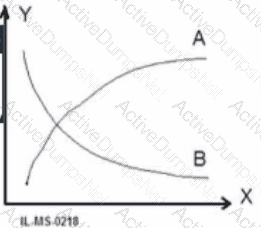
A)
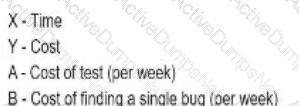
B)
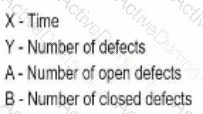
C)

D)
Which of the following BEST defines risk level?
Which of the following statements about error guessing is true?
Which are the MAIN goals of risk management in a software project?
Which one of the following statements correctly describes the term 'debugging'?
Which statement is true regarding confirmation testing and regression testing?
You are working on creating test cases for a user story -
As a customer, I want to be able to book an ISTQB exam for a particular date, so that I can find choose my time slot and pay the correct amount, including discounts, if any.
The acceptance criteria for this :
1. The dates shown should be from the current date to 2 years in future
2. Initially there should be 10 timeslots available for each day, 1 hour each, starting at 8 AM GMT
3. Maximum 5 persons should be able to select a time slot after which that time slot should become unavailable
4. First timeslot should have a 10% discount
Which of the following is the BEST example of a test case for this user story?
